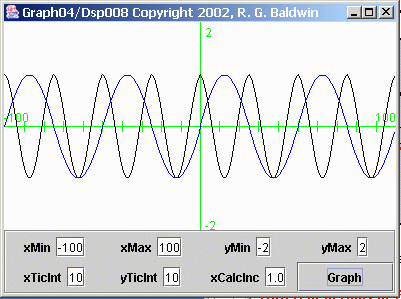| << Chapter < Page | Chapter >> Page > |
| Figure 4. Sinusoid with frequency modification. |
|---|
 |
The black curve in Figure 4 was produced by evaluating and plotting the following equation:
f(x) = cos(2*pi*x/25)
The blue curve in Figure 4 was produced by evaluating and plotting the following equation:
g(x) = sin(2*pi*x/50
Note that the periods (frequencies) for the black cosine curve and the blue sine curve in Figure 4 are not the same. The period (time interval between peaks) for the black curve is one-half that of the blue curve. Stated differently, the frequency of the black curve is twice that of the bluecurve.
(Frequency and period are reciprocals of one another. Period is a measure of the time required to complete one cycle of the function. Frequency is ameasure of the number of cycles that are completed in a given amount of time, usually one second.)
This difference exists because I modified the argument in the equation for the cosine function relative to the sine function. In particular, I halved thevalue in the denominator in the cosine argument relative to the denominator in the sine argument.
This caused the period of the cosine function to be only half as long as the period for the sine function. Stated differently, this caused the frequency of the cosine function to be twice the frequency of the sine function.
Although it isn't obvious, for any given value of x , the arguments for the sine and cosine functions shown above are angular measurements in radians .
Most programming languages provide methods for computing the sine and the cosine values for an angle given in radians. That is true for Java, and it isalso true for the plotting software used to produce these graphs. (These graphs were produced using a Java program.)
One cycle constitutes 360 degrees.
(For example, this is the number of degrees that the big hand on a clock must traverse to begin at the 12 and make one complete cycle around theclock face and back to the 12.)
Beyond one cycle, the values of the sine and cosine functions repeat.
An angle of one radian is approximately equal to 57.3 degrees, and is exactly equal to 360 degrees divided by 2*pi. Therefore, in order to use a method thatexpects to receive an angle in radians, it is necessary to apply the correction factor of 2*pi as shown above to convert from cycles to radians.
The horizontal scale in Figure 4 extends from minus 100 units to plus 100 units with a value of 0 in the center.
A tic mark appears every ten units. For x equal to 25, the argument for the cosine function equals 2*pi radians, or 360 degrees. A close examinationof Figure 4 shows that the cosine curve goes through one full cycle between an x value of 0 and an x value of 25. Beyond that, the cosine function simply repeats.
Similarly, for x equal to 50, the argument for the sine function equals 2*pi radians, or 360 degrees. Again, a close examination of Figure 4 shows that the sine curve goes through one full cycle between an x value of 0 and an x value of 50. Beyond that, the sine function simply repeats.

Notification Switch
Would you like to follow the 'Digital signal processing - dsp' conversation and receive update notifications?